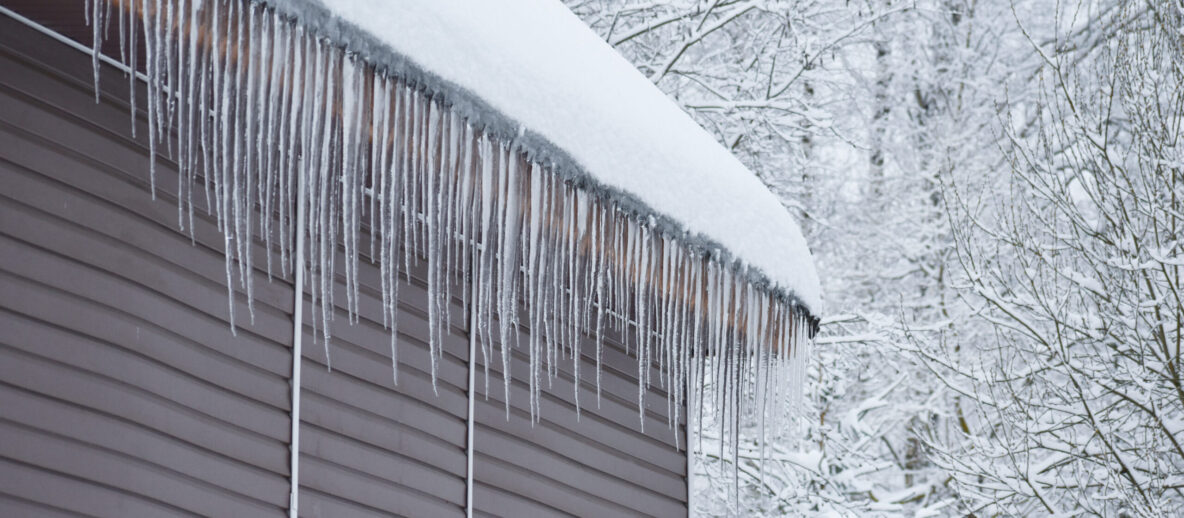Winter weather can be hard on your home’s roof. Heavy snow, ice, wind, and temperature fluctuations can cause wear and tear (and sometimes severe damage) on even the best-constructed roof.
Your home’s roof acts as a barrier, protecting you, your home, and your belongings from the elements. When that barrier is compromised, your home and its contents are at risk of damage. You probably know about the damage ice dams can cause to your roof and home. But another culprit of winter roof damage—the freeze-thaw cycle—is less well known.
To get you up to speed, let’s take a look at how this cycle of winter freezing and thawing can impact your home’s roof and how to prevent the damage it can cause.
What Is the Freeze-Thaw Cycle?
When temperatures rise, and the snow and ice that cover your roof in winter start to thaw out, the melted water can get into cracks in your roofing material.
Then, as temperatures drop again and that water refreezes, it expands, causing a buildup of pressure. When it thaws again, it contracts, and that pressure is released.
This is the freeze-thaw cycle, and it can cause the materials of your roof to erode. As temperatures fluctuate throughout the winter, this cycle of freezing and thawing adds stress to your roof’s shingles. This stress can result in lasting damage and significantly reduce your roof’s lifespan.
How the Freeze-Thaw Cycle Can Impact Your Home’s Roof
Even the sturdiest, most well-constructed roof can suffer damage from this cycle of freezing and thawing. As temperatures cycle above and below freezing, water that freezes and thaws on your roof has the potential to cause damage like:
- Cracks in roofing material. As water works its way into your shingles or other roofing materials, then expands and contracts as temperatures fluctuate, it can cause cracks. Left untreated, these cracks can expand further and cause roof leaks.
- Uneven spacing between shingles is another sign that the expansion and contraction process has caused damage. Unaffected shingles will be evenly spaced.
- Ice dams. When freezing and thawing happen often enough, it can cause ice dams to form on your roof’s edge. Ice dams cause snow to melt and run down your roof. That water then gets stuck behind shingles, creating pressure when it refreezes. Ice dams can cause severe damage to your roof if they aren’t dealt with properly.
- Loose flashing. Metal flashing sheets protect the seams of your roof on eaves and peaks, around your chimney, and more. If your flashing is out of place, that can be a sign that freeze-thaw damage has occurred. The gaps created by separated flashing can allow additional moisture into your home, causing damage to your home’s structure and interior.
When your roof is damaged like this, water can seep under your shingles and leak into your home. If left untreated, this can cause condensation and mildew inside your home as well as more significant long-term damage.
Prevent Freeze-Thaw Damage to Your Roof With Routine Inspections and Maintenance
Regular inspections (done once or twice a year) will help make sure your roof is in good condition and adequately ventilated, helping to prevent the damage winter weather can cause. When you have a professional inspect your roof, they’ll look for early signs of damage so you can catch minor problems before they become major ones.
In between inspections, take good care of your roof by regularly cleaning out your gutters, removing snow if it piles too high (check with your roofing contractor to know how much snow your roof can hold), and having minor repairs taken care of as soon as possible. Keep an eye out for ice dams and signs of roof leaks as well.
If you notice ice dams, leaks, or other signs of damage to your roof this winter, contact the team at Hoyt Exteriors to make the necessary repairs and ensure your roof will protect your home for years to come.

